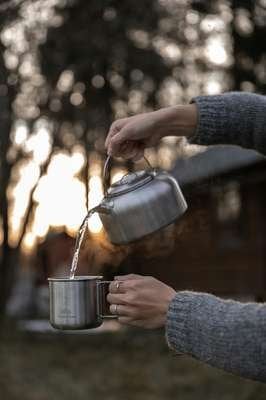Woman recounts 'extreme pain' after hot water bottle accident
By
Danielle F.
- Replies 29
In the chilly embrace of winter, many of us turn to the comforting warmth of a hot water bottle to fend off the cold.
It's a time-honoured tradition, especially among us who feel the chill a bit more.
What happens when this seemingly innocuous household item becomes a source of severe pain and danger?
A mum shared her harrowing tale and a warning for those who continue to do this practice.
Melbourne local Vanessa Pouthier suffered excruciating burns after using a hot water bottle to stay warm.
Little did she know, this decision would lead to 'extreme pain I've never known before,' as she described.
Vanessa was relaxing on her sofa with the hot water bottle on her lap when it suddenly split open, scalding her with boiling water.
The burst left her with severe burns, which required immediate medical attention.
Her husband and daughter called paramedics as she performed first aid in the shower.
The aftermath of the incident was a long and painful journey.
Vanessa was admitted to the leading burns hospital, The Alfred, where she underwent two surgeries, received skin grafts, and spent time in the intensive care unit.
Despite the trauma, she felt grateful for the level of care she received and acknowledged that she was 'in excellent hands'.
Burns clinical nurse Mel Neely from The Alfred highlighted the gravity of such injuries, noting that the hospital treats at least 50 patients annually for bottle burns.
'We often see people admitted to hospital for weeks, require multiple surgeries and grafting and lead them to permanent risk of scarring,' Neely said.
So, what can we do to prevent such a distressing event?
It's crucial to fill hot water bottles with hot—not boiling—water.
Avoid direct skin contact, and one should never lean, roll, or press against the bottle, as it can split and burst.
Moreover, hot water bottles are not everlasting—they come with an expiry date and should be replaced annually.
Nurse Neely also recommended using heat bags.
These alternatives can provide the same warmth without the associated risks.
While we seek comfort in the little things that help us through the colder months, safety should be our top priority.
Check your hot water bottles for signs of wear and tear, and consider safer alternatives to stay warm without the risk.

Have you or someone you know experienced a similar incident? What measures do you take to stay safe while keeping warm? Share your stories and tips with us in the comments below.
It's a time-honoured tradition, especially among us who feel the chill a bit more.
What happens when this seemingly innocuous household item becomes a source of severe pain and danger?
A mum shared her harrowing tale and a warning for those who continue to do this practice.
Melbourne local Vanessa Pouthier suffered excruciating burns after using a hot water bottle to stay warm.
Little did she know, this decision would lead to 'extreme pain I've never known before,' as she described.
Vanessa was relaxing on her sofa with the hot water bottle on her lap when it suddenly split open, scalding her with boiling water.
The burst left her with severe burns, which required immediate medical attention.
Her husband and daughter called paramedics as she performed first aid in the shower.
The aftermath of the incident was a long and painful journey.
Vanessa was admitted to the leading burns hospital, The Alfred, where she underwent two surgeries, received skin grafts, and spent time in the intensive care unit.
Despite the trauma, she felt grateful for the level of care she received and acknowledged that she was 'in excellent hands'.
Burns clinical nurse Mel Neely from The Alfred highlighted the gravity of such injuries, noting that the hospital treats at least 50 patients annually for bottle burns.
'We often see people admitted to hospital for weeks, require multiple surgeries and grafting and lead them to permanent risk of scarring,' Neely said.
So, what can we do to prevent such a distressing event?
It's crucial to fill hot water bottles with hot—not boiling—water.
Avoid direct skin contact, and one should never lean, roll, or press against the bottle, as it can split and burst.
Moreover, hot water bottles are not everlasting—they come with an expiry date and should be replaced annually.
Nurse Neely also recommended using heat bags.
These alternatives can provide the same warmth without the associated risks.
While we seek comfort in the little things that help us through the colder months, safety should be our top priority.
Check your hot water bottles for signs of wear and tear, and consider safer alternatives to stay warm without the risk.
Key Takeaways
- Melbourne mum Vanessa Pouthier was severely burnt when her hot water bottle burst on her lap, leading to surgeries and time in the ICU.
- Burns clinical nurse Mel Neely stated that The Alfred treats at least 50 patients annually for hot water bottle burns, which could lead to permanent scarring.
- To minimise the risk of burns, Neely recommended filling hot water bottles with warm water, avoiding direct skin contact, and replacing bottles annually.
- Health professionals also suggested using heat bags as a safer alternative.








